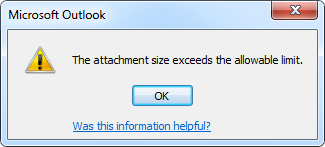

Use of Exchange Admin Center to change the mail size limit Let us have an easier way to set these limits, through the Exchange Admin Center. Thus, you can make use of Exchange Management Shell to manage the email size limit of your Exchange Server. New-TransportRule -Name LargeAttach -AttachmentSizeOver 10MB -RejectMessageReasonText “Message attachment size over 10MB – email rejected.” To check the Transport service emails limits, run this command: Check the current server limit on emails by running the following cmdlets. Use of Exchange Management Shell to change the mail size limitįirst, open Exchange Management Shell on your Exchange Server. Keeping these considerations in mind, let us understand how we can alter the default mail size limits in Exchange Server 2013.



But before that users should plan or consider some aspects related to the message size limits. However, as a solution to this issue, it is possible to set email size limits within Exchange Server using Exchange Management Shell and Exchange Admin Center. Heavy attachments in emails cause data to pile up and consume extra storage space. Reduce the Outlook limit by some 500KB to allow wiggle room.Managing mail flow in Exchange Server plays a vital role in effective database management. Ideally, the limit corresponds to your mail server’s limit.For no attachment file size limit, enter “0.” Practically all mail servers have a size limit, though, so “0” is not recommended you would invariably get large messages back as undeliverable after an often long and fruitless uploading process.The default value (with MaximumAttachmentSize not present) is 20MB or 20480.To set a size limit of 25MB, for example, enter “25600.”.Enter the desired attachment size limit in KB under Value Data:.Now double-click the MaximumAttachmentSize value you just created.Enter “MaximumAttachmentSize” (not including the quotation marks).Select Edit | New | DWORD Value from the menu.If you cannot see MaximumAttachmentSize:.Double-click the MaximumAttachmentSize value.Outlook 2016: HKEY_CURRENT_USER \Software\Microsoft\Office\16.0\Outlook\\Preferences.Outlook 2013: HKEY_CURRENT_USER \Software\Microsoft\Office\15.0\Outlook\\Preferences.Outlook 2010: HKEY_CURRENT_USER \Software\Microsoft\Office\14.0\Outlook\\Preferences.Travel down the registry tree to the entry corresponding to your Outlook version:.


 0 kommentar(er)
0 kommentar(er)
